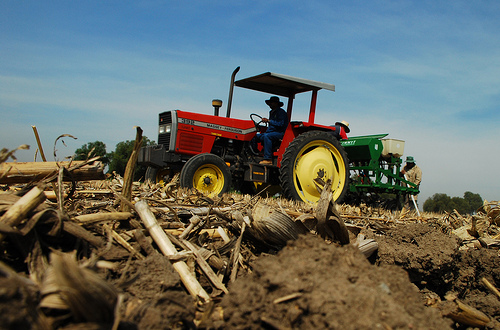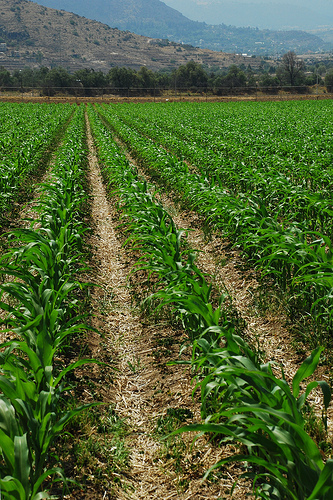
Conservation is an important part of federal farm funding — the laws that shape what, where, and how we grow our food. And yet, if the negotiations around the 2012 Farm Bill go as predicted, funding for conservation is in grave danger.
Why does conservation on farms matter? Well, for starters, most large-scale agriculture is a disruptive endeavor. It requires farmers to plow under native flora and replace it with giant monocultures of annual crops, and then coddle those crops by irrigating them and applying fertilizers, pesticides and herbicides — all ecologically damaging technologies.
There are ways to farm better, to wash away less soil and use fewer dangerous chemicals. But farming with a lighter footprint often costs more than it brings in, and until around the last decade, federal policy has done little to inspire conservation. Instead, farm subsidies encourage farmers to plant crops fencerow to fencerow with little regard to environmental impacts.
In 2002, though, the U.S. Department of Agriculture (USDA) began a program aimed a shifting the balance towards conservation. The shift continued after the 2008 Farm Bill, and the new program — the Conservation Stewardship Program (CSP), which pays farmers to implement measures that reduce erosion and chemical drift, minimize fertilizer runoff, and improve habitat for native pollinators — has grown every year. It’s now the most widespread conservation program in the country.
Farmers enrolled in CSP make seemingly small changes that can have a big impact over time. They may purchase new spray nozzles to reduce the amount of chemicals that drift into the air or water. Or they might plant borders around their fields to make homes for pollinators, implement no-till farming (which reduces soil erosion), or regularly test plants to finely calibrate their fertilizer usage. Ranchers and forest managers can also get into the conservation stewardship game, by agreeing to use techniques like rotating livestock so they don’t overgraze or planting buffers along riparian areas to enhance stream habitat.
None of this might sound radical, but the thing is — until recently — the most popular federal conservation program was one with the opposite strategy. The Conservation Reserve Program (CRP) paid farmers to stop doing their jobs — to take land out of production. While CRP has earned accolades from wildlife preservation groups and halted much soil erosion, its impacts were necessarily limited to the marginal land that farmers could spare, and it had no effect on lands under production.
The CSPfocus on working lands is a relatively new twist, supported by both sustainable agriculture advocates and production-oriented farmers. “(It) rewards farmers for doing the right thing rather than just pursuing the highest return possible from government farm programs,” said Ferd Hoefner, policy director for the National Sustainable Agriculture Coalition, a group that works to push sustainable agriculture incentives in U.S. farm policy.
And CSP has proven popular since widespread enrollment options were offered, after the 2008 Farm Bill. It surpassed the reserve program this year, at 37 million acres.
 Corn growing on wheat residue in a conservation plot.Photo: International Maize and Wheat Improvement Center“There was record turnout for the first signup … and it’s been really successful.” says Brad Redlin, director of conservation programs for the Izaak Walton League of America. Redlin likes the program because it doesn’t discriminate based on size and it lets farmers enroll regardless of whether they’re growing strawberries or soybeans.
Corn growing on wheat residue in a conservation plot.Photo: International Maize and Wheat Improvement Center“There was record turnout for the first signup … and it’s been really successful.” says Brad Redlin, director of conservation programs for the Izaak Walton League of America. Redlin likes the program because it doesn’t discriminate based on size and it lets farmers enroll regardless of whether they’re growing strawberries or soybeans.
Each state gets an allocation of acres under the program, and sets conservation priorities, like reducing erosion or improving water quality. Then, farmers compete for who can promise the most environmental benefits [PDF] on their land. The highest-ranking farms win CSP contracts, until the acreage cap for the state is reached. (The Natural Resources Conservation Service, the USDA agency that administers the program, grades the applications.)Five percent of those acres are also set aside for beginning farmers and ranchers, and another 5 percent for socially disadvantaged or limited resource applicants.
Once a farmer wins a contract, he or she is paid yearly on a per-acre basis for a five-year term. Payouts must average $18 per acre. Cropland rates run around $24 per acre, and rangeland around $4.
Carl Mattson, a Montana pea and wheat farmer, enrolled his 4,000 acres in 2004, when the program kicked off following the 2002 Farm Bill. He has implemented a number of conservation practices, including no-till and pesticide reduction. Mattson said his enrollment began during a 10-year drought when crops were doing poorly. During those lean years, he said, the income from CSP was a “very high” percentage of his total farm revenue.
“CSP allowed us to continue to maintain what we were doing conservation-wise and even allowed us to explore additional activities,” he says. Investing in these practices can mean buying pricey new equipment or sustaining less productive fields while they learn a new system, he adds. The payments help make surviving the transition possible.
In 2008, the USDA made some important changes to the program, some good, like expanding its scope, and others that both Mattson and Hoefner criticize. Now, instead of paying farmers who are already conservation-minded, the application process weights its scoring in favor of farmers adopting new practices.
“The old mantra for the early (2002) program was ‘reward the best and motivate the rest,'” says Mattson. But under the new system, farmers already practicing conservation have less of a chance to win contracts.
“That, unfortunately, has had the effect of keeping the best conservation farmers out of the program,” says Hoefner.
While some might see why the government wouldn’t want to pay farmers for something they’re already doing, Mattson says the program works better that way. When the program began, farmers like him, who were already practicing no-till, won contracts because of their early adoption. But after that, many farmers in his county who did not win contracts switched to no-till, in hopes that they’d win a contract. “You got over 50 percent of the farmers to change their practices without one single federal dollar, just because they wanted to be in line for the next go-round,” he says.
Now those farmers will not win contracts — unless they can promise to add still more new conservation practices. And that’s something Mattson and Hoefner would like to see changed in the next Farm Bill.
Right now, though, many conservation advocates are just hoping their programs don’t suffer major cuts. Paying for stewardship isn’t cheap — the government spends about $600 million on the program yearly.
As the congressional super committee is working to squeeze dollars from the overall national budget, as much as $23 billion could get cut from agriculture funding (in fact, some beleive the entire 2012 Farm Bill is being crafted quickly, behind closed doors). The National Sustainable Agriculture Coalition is working to inform their base about the danger of such cuts. And while CSP is popular among the agriculture community, it doesn’t yet enjoy the broad support held by the Conservation Reserve Program, which is by no means safe from cuts, either, but has the backing of a large group of hunters, fishermen, and others who benefit from wildlife habitat.
If the stewardship program shrinks in size, fewer acres will be farmed carefully. Or, conversely, we’ll lose more soil from our farmlands and we’ll see an increase in pesticides and fertilizer use.
Since switching to no-till, farmer Mattson has seen significant ecological improvements on his farm. His ponds no longer fill with soil from erosion. He uses less fertilizer, because his soil is healthier (and full of earthworms), and less fuel, because he doesn’t need to till as much.The Conservation Stewardship Program is working — for him, for farmers on 4 percent of the nation’s cropland, and for the air, water, and land it aims to protect.
“It’s an expensive program.” Mattson says, but, he adds, “if conservation is what the American public wants, this is a premier program to do it.”



